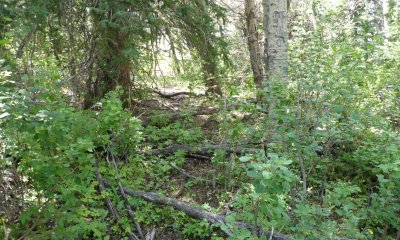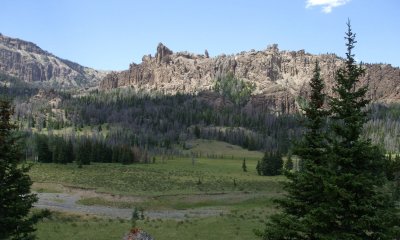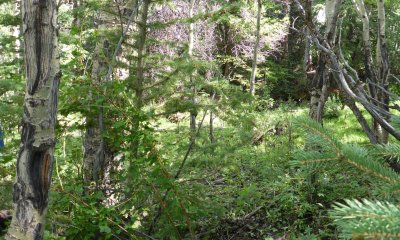
Subirrigated Cool Woodland Group
Scenario model
Current ecosystem state
Select a state
Management practices/drivers
Select a transition or restoration pathway
-
Transition T1A
Disease, insects or other disturbances removes engelmann spruce and leaves the site vulnerable to encroachment by subalpine fir.
More details -
Transition T1B
Soil disturbance (hoof action) with a seed source is the main driver to the invaded state.
More details -
Restoration pathway R2A
The removal of subalpine fir and rejuvenation of engelmann spruce with rest from grazing are the first steps in recovery of this site.
More details -
Transition T2A
Soil disturbance with a seed source present is the driver to this invaded state.
More details -
No transition or restoration pathway between the selected states has been described
Target ecosystem state
Select a state
Description
This state is a wet ecosite dominated by woody vegetation, namely englemann spruce. However, white bark pine and limber pine have been found within the community as well. These sites are a result of snow pack melt, or runoff that create these wet boundary communities. They can be found along the edge of wetlands, bogs/fens, or along toe slope areas.
Characteristics and indicators
The dominant tree canopy is engelmann spruce, with and under story of willow, shrubby cinquefoil, dogwoods or a host of other shrubs that trend towards wetter soils. Forbs such as marsh marigold, globeflower, and horsetail are common on these sites.
Resilience management
Fire is not a significant player in this community, however, the wet soils are fragile and deteriorate easily with grazing (trampling) or timber harvest (machinery), resulting in erosion or compaction that can impact the viability of engelmann spruce.
Submodel
Description
Slight changes in hydrology, due to compaction increased runoff, and aging of stands allows subalpine fir to increase on these wooded subirrigated sites. The increase encroachment in subalpine fir will result in a decrease or shift in the other woody species including shrubs.
Characteristics and indicators
The presence and indication of reproduction (both young and old growth stages) of subalpine fir are visbile in the community, and englemann spruce is declining. Willow, balsam popular and aspen are declining.
Resilience management
Soils are wet and fragile so deterioration is a threat from grazing (trampling) or timber harvest (machinery) resulting in soil erosion. Subalpine fir is able to tolerate dry soils and shallow to deep soils and so is able to persist as this site shifts or is degraded. Fire may pose a risk as the stand become more dense, but due to the moist nature it is not seen to play a significant role in this ecological site.
Submodel
Description
Increased use and movement through higher elevation communities has opened them to the threat of invasive species, including non-native invaders such as kentucky bluegrass. Little disturbance is needed to introduce these species, but once established they can quickly dominate the site.
Characteristics and indicators
This state resembles State 1 and State 2, but with the significant presence of a non-native invader including, kentucky bluegrass, redtop, smooth brome, and other species. Significant at this time is being considered to be 10% or greater of the total under story canopy cover.
Resilience management
These communities are resilient and resistant to change. The ability to reduce or eradicate most of the invader species is the management constraint of this state.
Submodel
Mechanism
Disease and insect damage due to aging or weakened trees, or major disturbance such as microburts, fire (although rare), or canopy removal of engelmann spruce leaves the site vulnerable to encroachment by subalpine fir. The ability to tolerate changes in hydrology and changes in the soil more readily is also thought to be a driver in this system, although more documentation is needed.
Constraints to recovery
Recovery time, and seed sources and conditions to allow the rejuvenation of engelmann spruce after the removal of subalpine fir and preventing further deterioration or invasion is the main constraints to recover.
Mechanism
The introduction of seed source with soil disturbance is the driver of this transition. Moving cattle through areas of known infestations, or wildlife traveling through the wet soils, plants the seeds and easily introduce non-native species such as kentucky bluegrass and smooth brome in to these areas. Other invaders such as houndstonue and canada thistle are a major issue in these soils as well.
Constraints to recovery
The inability to control or eradicate the non-native invaders without impact to the native species is the most understood constraint to recovery.
Mechanism
The use of fire or other timber management is needed to reduce the subalpine fir and encourage the rejuvenation of engelmann spruce to start the restoration to reference. Rest and mitigation to soil impacts on the site may be required.
Relevant conservation practices
| Practice | External resources |
|---|---|
|
Heavy Use Area Protection |
|
|
Wetland Wildlife Habitat Management |
|
|
Upland Wildlife Habitat Management |
|
|
Forest Stand Improvement |
|
|
Forest Land Management |
|
|
Grazing Management Plan |
|
|
Patch-burning to enhance wildlife habitat |
Mechanism
Recreation, timber harvest, grazing, wildlife, and wind are the major factors introducing seed sources for major invader species into these ecosystems. The hoof and track impact from any animal, human or vehicle is a means to incorporate the seed and start the invasion processes.
Constraints to recovery
The inability to eradicate or control the non-native invaders without impacting the site further is the largest constraint to recovery for this community.
Model keys
Briefcase
Add ecological sites and Major Land Resource Areas to your briefcase by clicking on the briefcase (![]() ) icon wherever it occurs. Drag and drop items to reorder. Cookies are used to store briefcase items between browsing sessions. Because of this, the number of items that can be added to your briefcase is limited, and briefcase items added on one device and browser cannot be accessed from another device or browser. Users who do not wish to place cookies on their devices should not use the briefcase tool. Briefcase cookies serve no other purpose than described here and are deleted whenever browsing history is cleared.
) icon wherever it occurs. Drag and drop items to reorder. Cookies are used to store briefcase items between browsing sessions. Because of this, the number of items that can be added to your briefcase is limited, and briefcase items added on one device and browser cannot be accessed from another device or browser. Users who do not wish to place cookies on their devices should not use the briefcase tool. Briefcase cookies serve no other purpose than described here and are deleted whenever browsing history is cleared.
Ecological sites
Major Land Resource Areas
The Ecosystem Dynamics Interpretive Tool is an information system framework developed by the USDA-ARS Jornada Experimental Range, USDA Natural Resources Conservation Service, and New Mexico State University.




